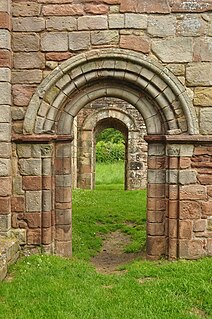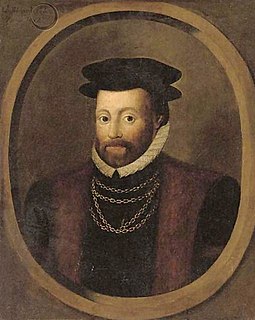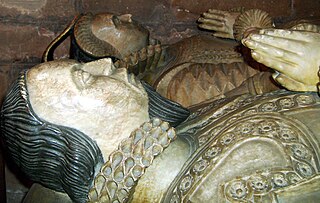
Sir John Giffard (c. 1465-13 November 1556), of Chillington in Brewood, was a soldier, courtier, member of the English Parliament and Staffordshire landowner, who made his mark mainly during the reign of Henry VIII.

Sir John Giffard (c. 1465-13 November 1556), of Chillington in Brewood, was a soldier, courtier, member of the English Parliament and Staffordshire landowner, who made his mark mainly during the reign of Henry VIII.
Giffard was the eldest son of Robert Giffard of Chillington by his second wife, Cassandra Humphreston, daughter of Thomas Humphreston. The Giffard family had been settled at Chillington since the late 12th century. [1]
Little is known of his early life. He married Jane Horde, daughter of Bridgnorth's wealthiest landowner, in 1483, when he was about 17 years old. About the age of 20, in 1486, his father Robert died and he inherited the substantial Giffard estates, centred on Brewood.
It is thought that Thomas Horde, his father-in-law might have advanced his career, perhaps introducing him at the royal court during the reign of Henry VII. Certainly he was well enough known there to be present in 1509 at Henry VII's funeral and at the coronation of his son, Henry VIII. [2] From that date he held important posts in the royal household, gentleman usher and sewer of the chamber, and it seems likely that he held them even earlier. He had been made a Justice of the Peace in Staffordshire in 1501, a post he held until his death.

From 1509 Giffard's career in royal service becomes known and notable. As well as the posts of gentleman usher and sewer, in which Henry VIII perhaps confirmed him, he was appointed Ranger of the Seven Hayes of Cannock Forest on 2 June 1509. A few months later, the title was altered to the less grandiloquent Ranger of Cannock Forest, and Giffard was to hold it until his death. [3] On 25 September 1513 he was knighted at the battle of the Spurs in France. However, in 1515, Giffard, now a widower, offended the king by remarrying without his permission. He was able to repair relations, but only after paying a fine.
Giffard was at court regularly for thirty years or more, and accompanied the royal family on many important state occasions. In 1520 he crossed the Channel again to attend the Field of the Cloth of Gold, Henry's meeting with Francis I of France, and was also at Gravelines two weeks later for the king's meeting with the queen's nephew, Charles V, Holy Roman Emperor. He was a confidant of both the king and the queen, Catherine of Aragon, but his position seems not to have been damaged when they separated. He was present at the coronation of Anne Boleyn on 1 June 1533. Late in 1539, he and his son, Thomas were sent to Kent to prepare for the arrival of Anne of Cleves at Dover Castle and at Sittingbourne. [4] Early in 1540 he also acted as whiffler, or horn-blower, when Anne was publicly received at Blackheath.
For all his attendance at court, Giffard was a serious soldier. In 1513, he distinguished himself [5] in Henry's invasion of northern France, in which English troops defeated the French at the Battle of the Spurs, going on to take the important stronghold of Tournai. He was allowed to carry the Royal Standard of England before the king [3] during this campaign, on which he was accompanied by his friend and near neighbour Edward Littleton of Pillaton Hall. It was after the taking of Tournai that he was knighted.
Giffard was granted a standard in 1523 and may have served in southern France. At some time by 1533, he was made a knight of the body, a member of the royal body guard, a courtly and military honour. In 1536 he was sent to help fight the Pilgrimage of Grace, the rising in Yorkshire and Lincolnshire against the Dissolution of the Lesser Monasteries Act.
Giffard's only definite period as a Member of the English Parliament was during the English Reformation Parliament, which lasted from 1529 until 1536. However, his name appears on subsidy commissions, the bodies charged with imposing taxation and made up mainly of MPs, between 1512 and 1524, so he may have held a seat outside Staffordshire before the known election.
Giffard's election in 1529 was as a knight of the shire for his native county of Staffordshire. He was placed first in the order of precedence, above his friend and neighbour Littleton. In the first half of the 16th century, most member for the county sat for only one term, and Littleton's record in serving in five parliaments was unique. Members came from a small circle of landed gentry families: Giffard was reckoned a leading man in the county at the time of his election – second only to the Earl of Shrewsbury. [2]
Giffard joined Queen's Head group – a discussion meeting of MPs in the Queen's Head tavern. [3] Another member of the group was Sir George Throckmorton, whose sister married Thomas Giffard. Throckmorton, Littleton and Sir John Giffard were all placed by Thomas Cromwell on a list believed to be of members opposed to the 1533 Statute in Restraint of Appeals. This abolished the right of appeal to the Pope in both civil and ecclesiastical cases, and opposition to it was considered a touchstone of religious conservatism. However, Giffard attended the coronation of Ann Boleyn at the end of the 1533 session, and there is no hint that he opposed any of the more radical reforms that came later. Thomas Giffard and Littleton were soon involved in friendly competition for the monastic properties made available after the dissolution of 1536, [4] [5] while Sir John himself enquired after monastic lands at the Blackheath reception 1540. [3]
It is possible that Giffard was feeling some disquiet at the pace of change, however, and on 5 June 1533 he obtained a licence for himself and his wife to leave the country on a pilgrimage to Amiens, a shrine of John the Baptist, celebrated for his resistance to royal power. It is not known how long they stayed in France, but it seems likely that Giffard returned for further sessions of the Reformation Parliament. He certainly went off northward to defend its decisions by force of arms in 1536. There is no record of who Staffordshire returned to Parliament in 1536, but Henry VIII had forcefully requested that all existing members serve again, so it is likely that both he and Littleton were re-elected. He was now over seventy years of age and his son Thomas took over from him in the 1539 election.

Giffard's main estate was Chillington, which had a small village, since disappeared, and a water mill, as well as the medieval moated and fortified manor house. Sir John carried out a complete reconstruction of the house on the same site. [1] The new hall was a quadrangular building house with a gatehouse on its eastern side – a plan similar to the roughly contemporary Pillaton Hall built by Edward Littleton. It was considered "remarkable for the various forms of its windows and chimneys." As the same site was also used for the extant Georgian house, only fragments of Sir John's building remain, probably including carved panels incorporated into the present fireplace of the saloon, thought to occupy the site of the 16th century great hall.
Allegedly Giffard kept a menagerie at Chillington, from which a panther escaped. The point at which he shot it with a crossbow is marked by Giffard's Cross, which is now in the garden of a small Georgian gate lodge. The original wooden cross, with its trefoil terminals to the arms, decayed and the present cross is a replica.
In addition to Chillington, Giffard inherited the small estate of Walton, near Eccleshall. He began to extend his family's holdings locally. In 1495 he leased the estate of Hatton from the Bishop of Lichfield By the time of his death he also held a substantial part of Broom Hall as tenant of the bishop, although it seems that Sir John made a wedding present of his land at Broom Hall to Thomas Giffard in 1531. The estate was divided between the Giffards and the Lanes of Bentley. One of Sir John's tenants at Broom Hall was Thomas Careless. This partnership of the Lane, Giffard and Careless families was to prove crucial in the Escape of Charles II in 1651. In addition to these important local acquisitions, he also obtained from the king a number of lordships in Staffordshire, including Plardiwick, near Gnosall, Pattingham and Marston.
As befitting an important landowner in the county, Giffard was pricked High Sheriff of Staffordshire in 1509 – part of a shower of honours that descended on him that year. However, he was also Sheriff a further five times: 1517–18, 1522–3, 1526–7, 1530–1, 1541–2.


Sir John Giffard married twice.
Giffard and his wives were interred in the parish church of St. Mary and St. Chad in Brewood. An impressive alabaster tomb was later installed, with part-gilded effigies of all three.

Sir John Seymour of Wulfhall in the parish of Great Bedwyn in the Savernake Forest, Wiltshire, Knight banneret was an English soldier and a courtier who served both Henry VII and Henry VIII. Born into a prominent gentry family, he is best known as the father of the Henry VIII's third wife, Jane Seymour, and hence grandfather of king Edward VI of England.

Elizabeth Seymour was a younger daughter of Sir John Seymour of Wulfhall, Wiltshire and Margery Wentworth. Elizabeth and her sister Jane Seymour served in the household of Anne Boleyn, the second wife of Henry VIII. In his quest for a male heir, the king had divorced his first wife, Catherine of Aragon, whose only surviving child was a daughter, Mary. His marriage to Anne Boleyn had also resulted in a single daughter, Elizabeth. The queen's miscarriage of a son in January 1536 sealed her fate. The king, convinced that Anne could never give him male children, increasingly infatuated with Jane Seymour, and encouraged by the queen's enemies, was determined to replace her. The Seymours rose to prominence after the king's attention turned to Jane.

Chillington Hall is a Georgian country house near Brewood, Staffordshire, England, four miles northwest of Wolverhampton. It is the residence of the Giffard family. The Grade I listed house was designed by Francis Smith in 1724 and John Soane in 1785. The park and lake were landscaped by Capability Brown.

Brewood is an ancient market town and civil parish in South Staffordshire, England. Located around grid reference SJ883088, Brewood lies near the River Penk, eight miles north of Wolverhampton city centre and eleven miles south of the county town of Stafford. Some three miles to the west of Brewood is the border with the county of Shropshire.

White Ladies Priory, once the Priory of St Leonard at Brewood, was an English priory of Augustinian canonesses, now in ruins, in Shropshire, in the parish of Boscobel, some eight miles (13 km) northwest of Wolverhampton, near Junction 3 of the M54 motorway. Dissolved in 1536, it became famous for its role in the escape of Charles II of England after the Battle of Worcester in 1651. The name 'White Ladies' refers to the canonesses who lived there and who wore white religious habits.
This is a list of the sheriffs and high sheriffs of Staffordshire.
Sir William Whorwood was a landowner in Staffordshire and the neighbouring counties, a distinguished lawyer, and a politician in the reign of Henry VIII. He achieved the positions of Solicitor General and Attorney General.
Margery Wentworth, also known as Margaret Wentworth, and as both Lady Seymour and Dame Margery Seymour. She was the wife of Sir John Seymour and the mother of Queen Jane Seymour, the third wife of King Henry VIII of England. She was the grandmother of King Edward VI of England.
Stephen Vaughan (1502-1549) was an English merchant, royal agent and diplomat, and supporter of the Protestant Reformation.

Edward North, 1st Baron North was an English peer and politician. He was the Lord Lieutenant of Cambridgeshire 1559–1564 and Clerk of the Parliaments. A successful lawyer, he was created the first Baron North, giving him a seat in the House of Lords.

Sir Hugh Pollard lord of the manor of King's Nympton in Devon, was Sheriff of Devon in 1535/6 and in 1545 was appointed Recorder of Barnstaple in Devon.

Black Ladies Priory was a house of Benedictine nuns, located about 4 km west of Brewood in Staffordshire, on the northern edge of the hamlet of Kiddemore Green. Founded in the mid-12th century, it was a small, often struggling, house. It was dissolved in 1538, and a large house was built on the site in Tudor and Jacobean styles by the Giffard family of Chillington Hall. Much of this is incorporated in the present Black Ladies, a large, Grade II*-listed, private residence.

Penkridge is a market town and parish in Staffordshire with a history stretching back to the Anglo-Saxon period. A religious as well as a commercial centre, it was originally centred on the Collegiate Church of St. Michael and All Angels, a chapel royal and royal peculiar that maintained its independence until the Reformation. Mentioned in Domesday, Penkridge underwent a period of growth from the 13th century, as the Forest Law was loosened, and evolved into a patchwork of manors of greatly varying size and importance, heavily dependent on agriculture. From the 16th century it was increasingly dominated by a single landed gentry family, the Littletons, who ultimately attained the Peerage of the United Kingdom as the Barons Hatherton, and who helped modernise its agriculture and education system. The Industrial Revolution inaugurated a steady improvement in transport and communications that helped shape the modern town. In the second half of the 20th century, Penkridge grew rapidly, evolving into a mainly residential area, while retaining its commercial centre, its links with the countryside and its fine church.

Edward Littleton or Edwarde Lyttelton was a Staffordshire landowner from the extended Littleton/Lyttelton family. He also served as soldier and Member of Parliament for Staffordshire in the House of Commons of England, the lower house of the Parliament of England, five times.

Sir Thomas Giffard was a Tudor courtier, Staffordshire landowner and Member of the English Parliament.

John Giffard (1534–1613) was a Staffordshire landowner and Member of the English Parliament, notable as a leader of Roman Catholic Recusancy in the reigns of Elizabeth I and James I.

Humphrey Swynnerton was a Staffordshire landowner, a Member of the English Parliament and an Elizabethan recusant.
Sir John Neville, of Chevet in Yorkshire, was an English landowner, courtier, soldier, administrator and politician who was executed for treason under King Henry VIII.

Sir Edward Littleton was a politician from the extended Littleton/Lyttelton family and an important Staffordshire landowner of the Jacobean era and the early Caroline era. Although loyal to the monarchy, he seems to have been of Puritan sympathies and was a close ally of Robert Devereux, 3rd Earl of Essex. He represented Staffordshire in the English parliament of 1624.

The Lyttelton family is a British aristocratic family. Over time, several members of the Lyttelton family were made knights, baronets and peers. Hereditary titles held by the Lyttelton family include the viscountcies of Cobham and Chandos, as well as the Lyttelton barony and Lyttelton baronetcy.